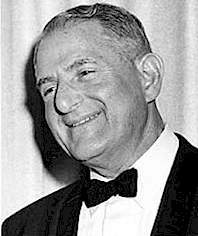Dan Daniel (Dan Daniel)

By 1924, Dan Daniel had settled at the New York Telegram, where he remained for the next forty years. In 1925, he won Best Story of the Year from the Baseball Writers’ Association of America for his portrayal of Walter Johnson’s loss in the seventh game of the Washington Senators/Pittsburgh Pirates World Series match-up. In the early 1920s, Daniel helped start The Ring with Nat Fleischer. He was a prolific contributor and editor throughout The Ring’s history and could be seen behind his desk at The Ring when he was well past the age of 80. In addition to his daily columns for the New York Telegram (later World Telegram then World Telegram and Sun), Daniel wrote weekly columns for The Sporting News, contributing more words to that publication than any other writer in its history. From 1930 through the 1960s, Daniel was a frequent contributor to Baseball Magazine and SPORT, along with other sporting publications of the day. His patriotic articles during World War II earned him wide praise. He was one of the first writers to identify the potential of both Joe DiMaggio and Mickey Mantle, extolling their virtues before either had swung a major league bat. In 1930, Dan Daniel was elected president of the New York chapter of the Baseball Writers’ Association of America. That year, New York Mayor Jimmy Walker made Daniel sports chairman of his Committee for Relief of the Unemployed. The committee organized the first college basketball games in Madison Square Garden and raised the equivalent of 5 million dollars between 1930 and 1933. Walker presented a citation to Daniel at a testimonial dinner held in his honor, the first time a private citizen had been so-honored by the city.
Also in 1930, Dan Daniel helped convince Babe Ruth to sign his record US$80,000 contract with the New York Yankees. Ruth had been holding out for more money and had threatened to boycott spring training in Saint Petersburg, Florida. Daniel helped Ruth come to the decision to sign by reminding him that many of his fans were out of work and selling apples on street corners back home in New York City. Later in 1930, Daniel published Babe Ruth, Idol of the American Boy. This early biography of The Babe was developed from material Daniel had published in a series of feature stories in the New York Telegram. It included a forward to boys from The Babe admonishing them to “do everything in moderation”! Starting in the 1940s, his “Ask Daniel” column ran in the World Telegram every Tuesday. Daniel answered thousands of baseball questions, becoming one of the game’s leading experts and historians. Each spring, Daniel put his reputation on the line by predicting how the eight teams in each league would finish. Cartoonist Willard Mullin captured the audacity of these predictions in charming caricatures. Daniel was an accomplished speaker and raconteur. He had a rasping voice and a biting wit, which made him a popular choice as master of ceremonies for sports dinners and roasts.
Dan Daniel was official scorer for more than twenty games during Joe DiMaggio’s 1941 hitting streak. His decisions are still criticized more than 60 years later, but Daniel maintained throughout his life that he called each play as he saw it. Shortly after Babe Ruth’s death in 1948, Daniel wrote The Real Babe Ruth, his second biography of the Babe, which contained many of his personal recollections from having been friend and advisor to Babe Ruth. In 1972, Daniel received baseball’s highest honor for a writer, the J. G. Taylor Spink Award at the Baseball Hall of Fame. In his acceptance speech, he thanked the players and the fans for “giving him the medium of a wonderful career”. He mused that without baseball, he would have ended up as a doctor and assured the audience that “Had I been a doctor, I would have made house-calls”. At the age of 86, Daniel was still a relevant contributor to the history of New York City sports. In 1976, he co-authored “Yankee Stadium Then and Now”, a feature article in The New York Times. Dan Daniel was a noted bibliophile and amassed a significant collection of first editions, befriending book sellers in the cities he frequented as he traveled with the Yankees and other teams. His collection included an imprint of Aristotle’s Art of Rhetoric, published by Gunther Zainer in 1476.
Born
- June, 06, 1890
- USA
- Springfield, Massachusetts
Died
- July, 07, 1981
- USA
- Pompano Beach, Florida
Cemetery
- Forest Lawn Memorial Gardens North
- Pompano Beach, Florida
- USA

